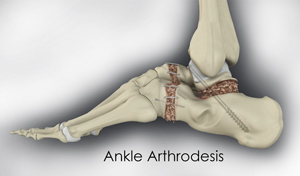Ankle Arthrodesis aka Ankle Fusion Surgery

Ankle fusions are presented to patients with end stage rheumatoid arthritis (RA) or post-traumatic osteoarthritis (PTOA) in which cartilage or lining of the joint have been lost. It is regarded as the ‘gold standard’ of treatment for end stage arthritic change in the ankle but is also used in patients with:
- Avascular necrosis (AVN)
- Benign but locally distinctive tumors
- Pigmented villonodular synovitis (PVNS)
How is an Ankle Arthrodesis Performed?
Ankle arthrodesis can be performed as an arthroscopic or open traditional surgery. The approach for an open technique can be either from anterior (front) aspect or lateral (side) aspect of the ankle. The joints are then fused together with the help of screws and/or plates or rods. Bone grafting is recommended in cases of substantial bone loss or poor biology. This is done using a graft taken from the patient (autograft) or donor tissue (allograft). The recovery time following fusion will depend on the technique employed and your health status.
Arthroscopic Ankle Arthrodesis: can be used when there is little mechanical deformity. It has the advantage of faster recovery as well as less soft tissue damage to the surrounding anatomy. There are also fewer complications when compared to open arthrodesis. The traditional approach vs arthroscopic approach is determined by advanced imaging and a consultation with Dr. Kennedy.
What is the Postoperative Care for Ankle Arthrodesis?
The postoperative guidelines to be followed immediately after ankle arthrodesis include:
- Keep your cast or dressing dry and do not remove for the specified time given by your surgeon.
- Avoid bearing weight on the operated ankle joint and use crutches or wheelchairs for 2-4 weeks,
- Elevate the foot above heart level to minimize swelling.
- Eating a healthy diet will help with healing. Stopping smoking 6-8 weeks prior to any surgery.
What are the Risks and Complications of Ankle Arthrodesis Surgery?
Ankle arthrodesis is usually a safe procedure and complications are uncommon. However, apart from general complications related to any surgery, complications after ankle arthrodesis can include infection, nerve damage, unresolved pain, non-union of bones, excessive swelling and stiffness, and irritation from foreign material such as pins or screws
Dr. Kennedy's Articles
Ankle arthrodesis: A systematic approach and review of the literature
Outcomes after standardized screw fixation technique of ankle arthrodesis
Outcome after single technique ankle arthrodesis in patients with rheumatoid arthritis

















